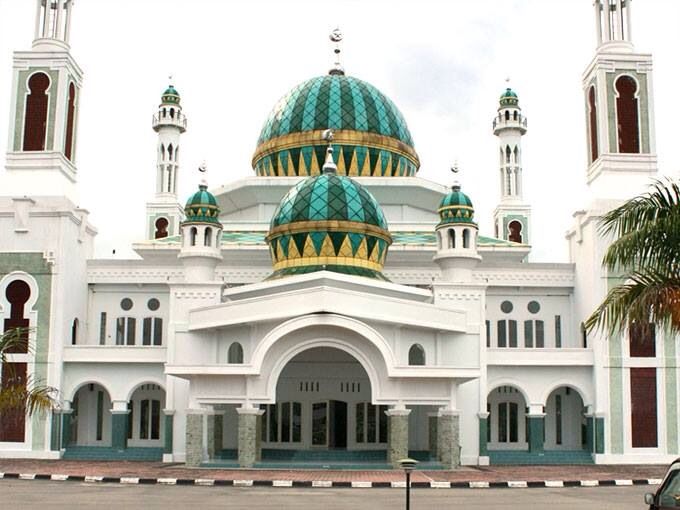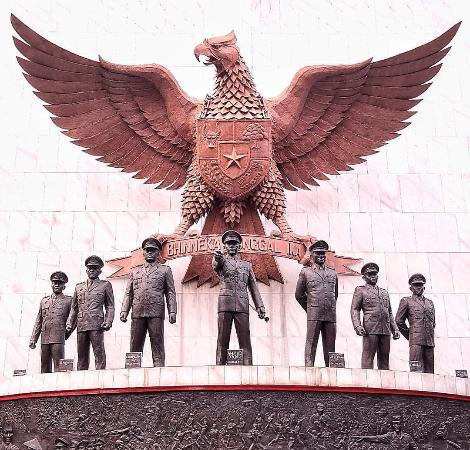by Religious Nationalism, 01 June 2017. Today is Pancasila day. This is the first time Indonesians are celebrating this national holiday. Pancasila is the national ideology of Indonesia. As explained before (see Indonesian Elections: A victory for Pancasila nationalism), Pancasila, meaning ‘five principles,’ highlights five aspect of Indonesian national ideology: monotheism, humanism, unified nation, representative democracy and social justice. More than 80% of Indonesians were Muslim at the time of independence but its founding fathers to have a pluralistic civic nationalism, which was not strictly secular but rejected majoritarian religious nationalism.
 |
| The Big Masjid in Semarang |
For a long time, Pancasila was not under threat, but with the return of democracy and the rise of a new elite, religious movements/groups are demanding a more conspicuous place for majority religion in the political sphere. The situation is increasingly comparable to India, which also rejected majority Hindu religious nationalism at the time of independence but is now ruled by the Bhartiya Janata Party, a revivalist Hindu chauvinist party:
Indonesia and India also share many characteristics which makes their comparison compelling. Both Indonesia and India were successor states of colonial empires. As there was almost no history of a united India or a united Indonesia before colonial times, nationalist elites of both countries had to perform an exhausting balancing act. They had to fight against the colonial state but also try to preserve it. Preservation of the colonial state was difficult as not only the boundaries of the colonial state were new (similar to many other colonial states), but these states also had mind-boggling diversity. To deal with the ethnic/linguistic/religious/caste/tribal diversity, nationalist elites of both India and Indonesia adopted civil nationalism so that all communities can identify with the new state, ignoring the demands of many Hindus in India and many Muslims in Indonesia. This decision was one of the main reasons why both these states have not only managed to stay intact for the last sixty years but also showed impressive progress.
Another similarity between Indonesia and India is the recent rise of new elites; elites quite different from the leaders that had governed both these countries since independence. For more than half a century, the civic nationalism imposed by the founding fathers of both states was not under threat. There was some criticism but it lacked broad popular support. Nineteen nineties brought a big change in both countries. Economic crisis in both countries (India in 1990-91 and Indonesia in 1997-98) jolted people out of their slumber and the spell that founding fathers’ ideas had on the nation was broken. Suharto and aged Congress leadership, defenders of the old ideas, lost their grip on the country and were thrown out. New elites were ‘outsiders’. Never before they had held power collectively. Their defining characteristics were overt religiosity and aggressive nationalism. This combination posed a threat to the civic and secular nationalism, both nations had adhered too since independence. (see Modi, Prabowo, and the threat to Indian and Indonesian civic nationalism)
Although Pancasila promotes inclusion and unity, for half a century, the day to commemorate Pancasila was linked with authoritarianism, exclusion and the killing of half a million Indonesians by their fellow countrymen in 1965-66. It was General/Acting President Suharto who first ordered the celebration of the Pancasila Day in 1967. At that time, it was called Hari Kesahtian Pancasila (Sacred or Devine Pancasila Day) and celebrated on October 1st each year. The day was used to justify the 1965 coup, the New Order regime led by Suharto and possibly the massacre that happened soon after the coup. The birth of Pancasila on June 1st, 1945 was downplyed.
Much of what happened on October 1, 1965 is still contested but what is largely accepted by all sides is that six senior Indonesian military generals and one junior officer were killed by communists. This event gave the opportunity or forced General Suharto to take over the control of the government. Katherine McGregor, in her Asian Studies Review article published in 2002, writes about Suharto and the commemoration of the Hari Kesahtian Pancasila:
Suharto also made the decision in 1967, his first year as Acting President, to commemorate 1 October, the day on which the six generals were kidnapped and murdered and on which he, together with the army, suppressed the coup attempt. He was clearly determined to ensure that the official version of the coup attempt, in which the army victims were martyrs and Suharto the triumphant hero, would not be forgotten. For every year of the New Order Hari Kesaktian Pancasila was celebrated in a ceremony at Monumen Pancasila Sakti. The themes taken up in the ceremony replicate themes of the initial propaganda surrounding the coup including an emphasis on the coup attempt as a communist plot; the horror of the deaths of the army heroes; the religious and moral deviance of the communists; warnings about the return of communism; and 1 October as a day on which the Pancasila was resurrected. These messages were variously encapsulated in the reading of the Pancasila text, the Pancasila ikrar [pledge]4 and a prayer during the course of the ceremony. Suharto was inspector of the ceremony for every year of the New Order. As principal actor in the events of 1 October Suharto’s presence added authenticity to the commemoration. The two main roles he performed in the ceremony were to lead a silent reflection and to inspect the monument at the conclusion of the ceremony.
It was made the most important day in the national calender and a national monument and a museum were later added to make the official version of October 1, 1965 events difficult to deny or contest.
Pancasila sakti monument, with its seven victims under Garuda, Javanese eagle that is the national symbol of Indonesia (Source tripadvisor.com.sg)
Sacred Pancasilla Day was used to delegitimie enemies of the New Order. Initially, it was the communists, both foreign and domestic, and those working for democracy. Later, in the 1980s, religious Muslims were added to list but in the 1990s, they were excluded. In 1995 and 1996, Suharto’s political party Golkar and the a faction in Indonesian military used the day to rally Muslims to support Suharto.
After fall of President Suharto in 1997, there was an attempt to revisit the reasons for the Sacred Pancasilla Day on October first. Many gaps in the official story promoted under Suharto were discovered and the celebrations were subdued. Although President Abdur Rehman Wahid apologized to the former members of the Indonesian communist party and proposed to the end ban on their party in early 2000, but he decided to continue official celebrations on October 1st as Pancasila was owned by him and Vice Megawati Sukarnoputri as the national ideology. Megawati, infact, rightly linked Pancasila to her father, the founder and first President of Indonesia, Sukarno. It was he who first came up with the term (and five principles) on June 1st, 1945 to unite all Indonesians. Suharto hijacked the national ideology to use it for his own purposes. President Wahid and Megawati, however, change the name of the day to ‘Peringatan Hari Pengkhianatan (terhadap) Pancasila’ (the Commemorative Day for the Betrayal of the Pancasila). This change kept the Pancasila but changed the focus of the day from Suharto’s heroism in saving the nation from communists to his coup and the massacre afterward. Megawati led the day’s celebration ceremonies in 2000 (in place of President Wahid), but did not visit the musuem or the monument. When Megawati herself became President, she did not attend the ceremonies in 2003 and 2004, although the day was celebrated and ceremonies held at the monument. In 2004, Megawati was defeated by former general Susilo Bambang Yudhoyono and he started leading the October 1st ceremmonies again.
In 2014, Joko Widodo (a.k.a Jokowi) of Megwati’s party became the seventh President of Indonesia. He dutifully led the October 1st ceremonies at the monument in 2015 and 2016 but was under pressure to act. In 2015, Megawati urged him to declare June 1 as the Pancasila Day to link Pancasila with Sukarno (her father) and its birth in 1945 and disentangling it from its fifty year Suharto past:
In an emotional speech, Megawati said that without Pancasila, there would be no such thing as the unitary state of the Republic of Indonesia, as Pancasila was not merely the nation’s ideology, but also a tool that unified the nation. Therefore, she added, the country should commemorate the founding of Pancasila.
“Happy anniversary of Pancasila; let the nation rise with the spirit of Pancasila,” she said. “Let’s make the Pancasila of June 1, 1945, the way of life for our nation, to keep moving forward,” she said, her voice shaking as she held back tears. (See Jokowi grants Megawati’s wish on Pancasila)
Nahdatul Ulama, Indonesia’s largest Muslim organization, also supported Megawati’s call. In 2016, President Jokowi announced June 1st as Pancasila Day and a national holiday in the presence of Megawati.
The saga of the Pancasila Day reaffirms the constructivist nature of national ideologies. National ideologies are not premordial but are conceived, proclaimed and later discarded and replaced by men. Sometimes, the name of the ideology remians the same, but the ideas linked to it change,




